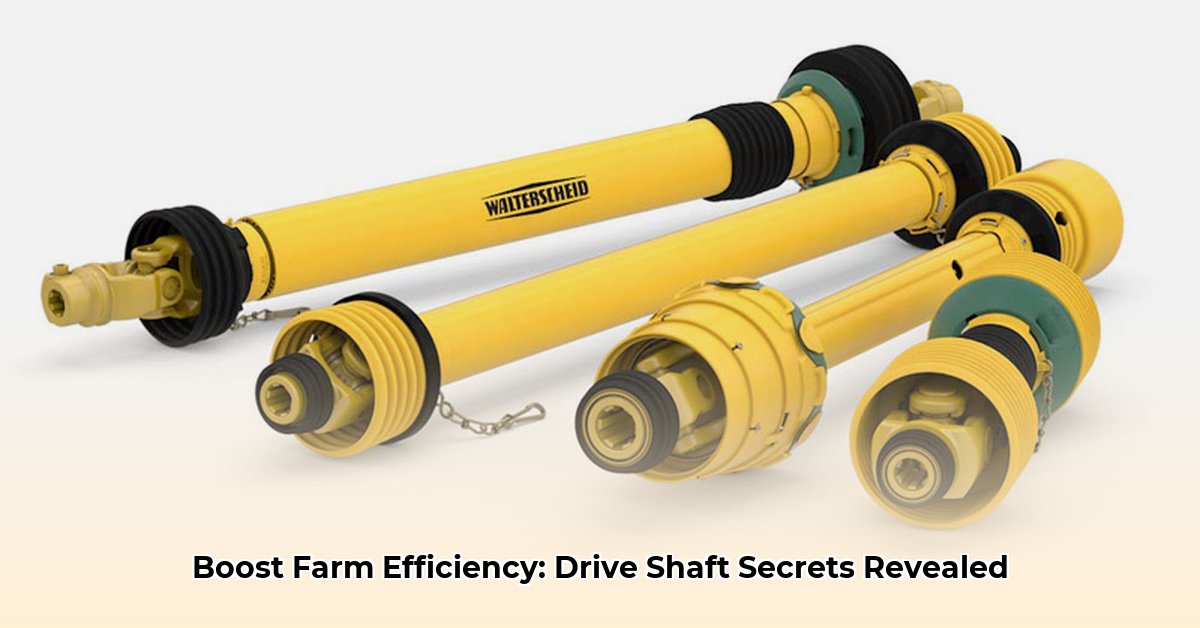
This comprehensive guide helps you understand, use, and maintain PTO shafts for a more efficient and sustainable farm operation. We'll cover everything from selecting the right shaft to performing regular maintenance, ensuring your equipment runs smoothly and minimizes environmental impact. This guide is designed for farmers of all experience levels, providing actionable steps and valuable insights. For more information on tractor PTO systems, check out this Kubota MX6000 resource.
Understanding Your Tractor's Power Take-Off (PTO)
The Power Take-Off (PTO) shaft is a critical component of your drive shaft tractor, transmitting power from the tractor's engine to various implements like planters, sprayers, and tillers. Instead of manually operating each machine, the PTO streamlines your workflow, increasing overall efficiency. This efficient energy transfer is crucial for sustainable agriculture, enabling practices like reduced-tillage farming that improve soil health and minimize environmental impact. Think of it as the powerhouse behind many of your farm's most crucial operations.
Choosing the Right PTO Shaft: A Crucial Step for Sustainability
Selecting the correct PTO shaft is paramount for both safety and efficiency. A poorly chosen shaft can lead to equipment failure, wasted resources, and potentially dangerous situations. Factors to consider include your tractor's horsepower, the implement's specifications, and the specific task. Using a shaft that's too small risks breakage and damage, while an oversized shaft wastes energy and resources. The goal is to find the optimal size—the sweet spot for peak efficiency and minimal environmental impact. Proper shaft sizing minimizes wear and tear, extending its lifespan and reducing your farm's carbon footprint.
Do you want to avoid costly repairs and frustrating downtime? Investing time in proper shaft selection is essential.
Optimizing Your PTO Shaft for Different Farm Tasks
The versatility of the PTO shaft allows it to power a wide range of implements for various farming tasks. This adaptability enhances efficiency and promotes environmentally friendly practices.
No-Till Planting: A properly sized PTO shaft powers no-till drills, minimizing soil disturbance, conserving soil moisture, and improving overall soil health. This method is key to sustainable farming practices and environmental protection.
Precision Spraying: PTO-driven sprayers provide accurate chemical application, reducing waste and protecting the environment. Precision spraying minimizes chemical usage, leading to both cost savings and environmental benefits.
Reduced Tillage: PTO-powered implements, such as strip-tillers, reduce fuel consumption and promote better soil health compared to conventional tillage. Reduced tillage practices are vital for sustainable agriculture, preserving soil structure and minimizing erosion.
Remember, always follow the manufacturer's instructions for safe and efficient operation.
PTO Shaft Maintenance: A Simple Routine for Long-Term Savings
Regular maintenance is essential for maximizing the lifespan and efficiency of your PTO shaft. Think of it as preventive care, keeping your tractor running at peak performance. A simple, consistently applied maintenance routine yields substantial long-term benefits.
Regular Inspections (Monthly): Conduct thorough inspections, checking for cracks, bends, or loose components. Pay close attention to vibrations during operation, as these can indicate underlying issues. Early detection is crucial for preventing major problems and costly repairs.
Proper Lubrication (Every 50 Hours): Maintain proper lubrication using the correct type of grease, as recommended by the manufacturer. This prevents friction, extends the life of the shaft, and ensures smooth operation. Remember, proper lubrication is a small effort with a big payoff in terms of equipment longevity.
Timely Replacements: Replace damaged shafts promptly. Delaying repairs can lead to escalating problems, potential injury, and significant financial losses.
Safe Storage: When not in use, store the shaft safely in a clean, dry location, protecting it from potential damage. This will extend its lifespan and avoid unnecessary replacement costs.
Consistent maintenance minimizes downtime, extends your equipment's life, and ultimately saves you money. Proper maintenance isn't just about the equipment; it's about making smart financial decisions.
Sustainability and the Future of PTO Technology
Drive shaft tractors and their PTO systems are vital for sustainable agriculture. Ongoing research is continually improving their efficiency and environmental impact. Expect further advancements in materials science and control systems, leading to lighter, more resilient shafts and more efficient power transfer. This ongoing evolution means that your investment in responsible farming practices today will continue to yield benefits for years to come.
Dr. Emily Carter, Agricultural Engineering Professor at Cornell University, emphasizes, "Sustainable agriculture depends on efficient machinery. Advancements in PTO technology are pivotal in reducing our environmental footprint while increasing productivity."
How to Choose Sustainable PTO Shafts for Precision Agriculture
This section provides a step-by-step guide on choosing sustainable PTO shafts that boost efficiency and minimize environmental impact in your precision agriculture operations.
Step-by-Step Guide: Choosing the Right PTO Shaft
Accurate Measurements: Precisely measure the distance between your tractor's PTO and the implement's input. Accurate measurement prevents binding or excessive slack.
Check Specifications: Verify compatibility between your tractor's and implement's specifications, ensuring correct diameter, spline type, and speed.
Duty Considerations: Select a heavy-duty shaft for frequent, demanding tasks; lighter-duty shafts suffice for less strenuous applications. The right shaft is essential for longevity and efficient operation.
Safety First: Always use safety shields and chains. These are non-negotiable safety components that prevent serious injury.
Regular Inspections: Regularly inspect for wear, cracks, or bending, replacing damaged shafts immediately to prevent catastrophic failure.
Sustainable Materials: Opt for durable, high-quality materials to reduce waste and minimize your environmental footprint. The initial cost of a high-quality, sustainable PTO shaft is offset by its extended lifespan and reduced replacement needs.
Optimizing PTO Shaft Use and Maintenance
Optimized PTO shaft usage and diligent maintenance are crucial for both efficiency and sustainability. This includes ensuring proper lubrication, performing regular visual inspections, and storing the shaft properly when not in use. Regular maintenance isn't simply about repair; it's about investing in the longevity of your equipment. Investing in your equipment is an investment in your farm's future.